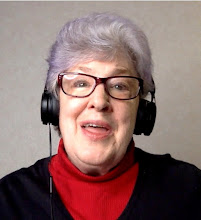Yesterday (Sunday) a colleague and I gave a presentation at the local JALT (Japan Association for Language Teachers) meeting. Our presentation was, in fact, on how to present, which, in a sense, put more pressure on us because the way in which we presented might be scrutinized more than in the usual presentation.
Basically we were satisfied with how well it went. Our strongest point was sticking to the time limits which we had set for each activity. Also, the pacing was generally good - too slow, according to the feedback of one participant, but we had to take into consideration that nearly half the audience consisted of non-native speakers, including 6 Japanese university students.
My co-presenter, Wilma Luth, and I made the decision that, if we were giving on presentation on effective ways of giving presentations (forgive the redundancy), it wouldn’t do for us to stand in front and simply give our listeners a bunch of tips. We wanted to demonstrate an effective presentation. In other words, the medium was the message.
Unfortunately, even though the presentation itself was well-received, the message was a little too subtle for most of those present. Some wanted more actual tips, and one person commented that it was rather thin.
There are three ways that our presentation could have been more effective, even great. The first is that we broke one of the “rules” of presenting in that we didn’t make it clear the direction we were taking. In fact, the notes I had written beforehand on Presentation Points included, “Give the audience an overview of what's going to be covered.”
The participants were particularly confused when it came to the second part, which started with 20 minutes by a different presenter on the topic of writing abstracts. They didn’t realize that Wilma and I were going to continue with moving from everyone talking about what excited them in their teaching to thinking about how they could turn that into a presentation. We knew, but it would have been nice if we could clued the audience what we were doing!
Another way in which the presentation could have been improved is by giving more examples, either from our own experiences as presenters or from presentations, both effective and ineffective, that we had been to. Our assumption was that examples were something that would come up in group discussion, which they did. What was lacking was sharing those with the audience. Everyone seemed to enjoy hearing the “war stories,” and concrete examples make the points more memorable.
A final way in which the presentation would have been truly effective is to give some questions to the participants at the end about the way in which we had presented. Although they were aware of how we were managing time, since that was what we used as an example to introduce the brainstorming in small groups, there was too much on the subliminal level that escaped the awareness of all but the most experienced presenters. A few of the questions we might have asked include:
o Where did the presenters stand during the presentation? [possible answer: not behind the podium, but generally in front when giving explanations and moving around during group discussion]
o How did the presenters get the participants involved immediate? [possible answer: by taking a poll]
o What did the presenters do with points elicited from the audience? [possible answer: repeated and rephrased them, then put them on a screen for all to see]
o What was the effect of the pacing of the presentation? [possible answer: participants had times for interaction, times when they could sit back and listen, with none of the segments being excessively short or long (taking into consideration the varying language levels of the participants)]
o How was humor used during the presentation? [possible answer: “touch one’s nose” during the initial poll, photos of the cats during the Keynote slideshow, anecdotes]
At any rate, if our presentation stimulated those who were present to think more about what and how they could present, we achieved our goal. Rather than flaunting ourselves as experts in the area, since nearly two-thirds of the participants (we discovered by a show of hands) had presented, we wanted them to reflect on their own experiences and be aware of what they already knew about what makes an effective presentation. As for novices, we hoped they would gain the confidence that they could give presentations and actually begin to think about doing so.
By sharing these reflections on our presentation on the JALT website, we also want to show that a presentation is an on-going process, including planning stages, the actual presenting, and reflection afterwards.
People I've blocked on Reddit and why, Jan 2026 version
-
Even more than Substack, I wish I had started this long ago.
Better late than never.
A few things are guaranteed to get you blocked.
One is being a win...
21 hours ago





No comments:
Post a Comment